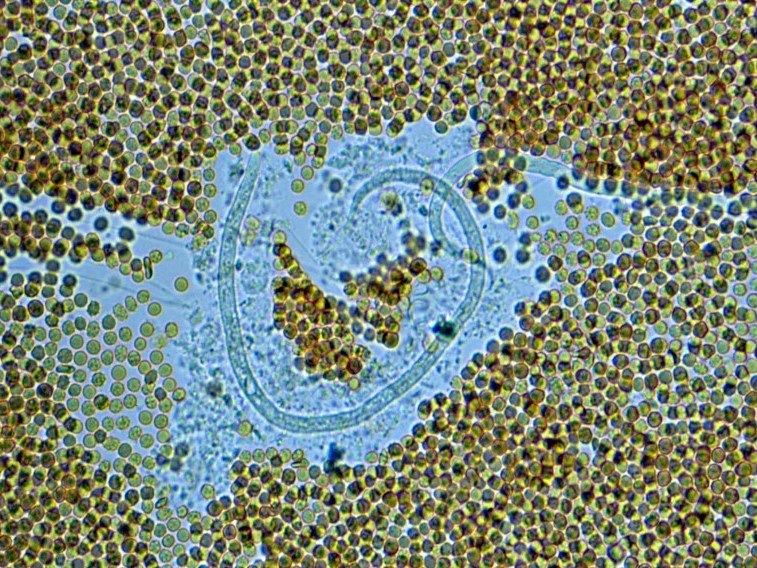HIV: Filarial worm infections double the risk of infection
Advertisement
Since the start of the HIV epidemic, there have been speculations as to why HIV and the immunodeficiency syndrome it causes have spread so much more in Africa than in other countries around the world. Scientists from the German Center for Infection Research (DZIF) have now, for the first time, confirmed one reason for this: in a cohort study conducted in Tanzania, they discovered that an infection with the filarial nematode Wuchereria bancrofti increases the risk of HIV infection by two to three fold.

Infections with the roundworm Wuchereria bancrofti cause lymphatic filariasis.
© Achim Hoerauf/Uniklinikum Bonn
“Adolescents and young adults are particularly affected: they showed an approximate three-fold increase for the risk of HIV infection when infected with Wuchereria bancrofti,” explains Dr. Inge Kroidl from the Department of Infectious Diseases and Tropical Medicine at the University of Munich Medical Center (LMU). Scientists at the LMU Tropical Institute conducted this 5 yearlong population based cohort study together with scientists from the University Hospital of Bonn, as well as with DZIF African Partner Institutions in Tanzania.
Wuchereria bancrofti : a worm infection with severe consequences
Infections with the thread-like roundworm Wuchereria bancrofti cause lymphatic filariasis (LF), a disease of the lymphatic vessels that, in the worst case elicits elephantiasis. Images of elephant-like deformed limbs are not uncommon in these endemic regions of Africa. The drug combinations used to treat these infections in African communities are only effective against microfilariae, the worms offspring which enter the blood stream and from there are transmitted further by vector mosquitoes. In contrast, adult worms often reside in the hosts lymphatic system and can survive for many years. LF infections in the participants of the study currently published in the Lancet were diagnosed by a positive circulating filarial antigen (CFA) test.
Study confirms a connection between filarial infection and risk of HIV infection
This study was designed to identify risk factors for HIV infection in the general population of southwest Tanzania. A sub-group of 1,055 people was subsequently tested for roundworm infection (filariasis). Over the study period, a total of 32 new HIV infections were described. People with filariasis compared to those who did not have filariasis had a 3.2 fold increased risk of HIV infection in the age group 14 to 25 years and a 2.4 fold increased risk in the age group 25 to 45 years. Those over 45 years had a 1.2 fold increased risk.
“Now, after this longstanding theory has been confirmed, the work is really just beginning,” explains Prof Michael Hoelscher, Director of the Tropical Institute in Munich, LMU and initiator of the cohort studies which were started in 2006. Further studies have been planned together with researchers from the University Hospital of Bonn. “What is important now is to find therapies that also rapidly eliminate the adult W. bancrofti worms,” emphasises Prof Achim Hörauf, whose career has revolved around filariasis research and within the DZIF, strives to develop novel drugs to treat these worms.
“The results of this study are interesting, also from an immunological standpoint. They can help us to better understand factors which facilitate infection, and consequently help find preventative and therapeutic approaches,” says Prof Hans-Georg Kräusslich, Director of Virology at the University of Heidelberg and coordinator of the DZIF research field “HIV”.
Long-term research funding for Africa
European Commission funding has made these results possible. Together with the Tanzanian Ministry of Health, the European Commission started strengthening research capacities in the Tanzanian healthcare system ten years ago. The Federal Ministry of Education and Research (BMBF) has also contributed to these developments and has dedicated itself to further strengthening healthcare research in Africa in 2011. Amongst other things, their commitment is highlighted by the support of 5 research networks for health innovation in sub-Saharan Africa which have a total funding budget of around 50 million euros starting this year. TAKE-OFF, one of the five networks, is dedicated to filariasis research. In this network, Prof. Hörauf and Dr. Kroidl will continue their successful research in the fight against filariasis with collaborators in three African countries. Klaus Rudischhauser, Deputy Director-General at the Directorate General for International Cooperation and Development shared his enthusiasm, “This success has clearly demonstrated how long-term funding can contribute to developing novel interventions for major diseases like HIV.”




























































